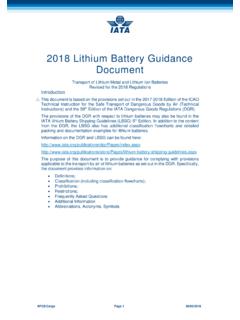Transcription of A Critical Review of Thermal Management Models and ...
1 A Critical Review of Thermal Management Models and Solutions of lithium -ion Batteries for the Development of Pure Electric Vehicles Qian Wang, Bin Jiang, Bo Li, Yuying Yan*. Fluids & Thermal Engineering Research Group, Faculty of Engineering, University of Nottingham, UK. Corresponding author: Abstract Power train electrification is promoted as a potential alternative to reduce carbon intensity of transportation. lithium -ion batteries are found to be suitable for hybrid electric vehicles (HEVs) and pure electric vehicles (EVs), and temperature control on lithium batteries is vital for long-term performance and durability. Unfortunately, battery Thermal Management (BTM) has not been paid close attention partly due to poor understanding of battery Thermal behaviour.
2 Cell performance change dramatically with temperature, but it improves with temperature if a suitable operating temperature window is sustained. This paper provides a Review on two aspects that are battery Thermal model development and Thermal Management strategies. Thermal effects of lithium -ion batteries in terms of Thermal runaway and response under cold temperatures will be studied, and heat generation methods are discussed with aim of performing accurate battery Thermal analysis. In addition, current BTM. strategies utilised by automotive suppliers will be reviewed to identify the imposing challenges and Critical gaps between research and practice. Optimising existing BTMs and exploring new technologies to mitigate battery Thermal impacts are required, and efforts in prioritising BTM should be made to improve the temperature uniformity across the battery pack, prolong battery lifespan, and enhance the safety of large packs.
3 Keywords: Low carbon vehicles, lithium -ion battery Thermal Management , heat pipe, pure electric and hybrid cars 1. Introduction Transportation has become the most growing factor of the world's fuel consumption taking up 49% of oil resources [1]. The efficiency of oil utilisation in vehicles is fairly low, so energy saving strategies in transportation will help reduce unnecessary energy consumption without providing extra utility and services [2]. One of the most distinctive energy saving ideas is the promotion of clean or green energy vehicles. Great attention has been paid to hybrid electric vehicles (HEV), plug-in hybrid electric vehicles (PHEV), and pure electric vehicles (EVs) as potential alternatives to reduce carbon intensity of transportation.
4 It is claimed that these vehicles provide solutions in zero-carbon emissions [3], offer the best possibilities for the use of new energy sources, and benefit long-term energy savings [4-6]. Andersen et al. [7] pointed out that EV reduces up to 20% in GHG emissions and further up to 40% if the electricity is generated by renewable energies. Endo [8] predicted that high efficiency vehicle developments may cut CO2 emissions to 2/3 of the level in 1990 by 2050. More importantly, opportunities are offered to EVs, since the US government offers billion funding and grants for a variety of EV related companies, and China shifts the focus to develop EV related economic and energy policies [9]. The fundamental challenge for clean energy vehicles to be commercialised is energy storage.
5 Developing a proper battery pack for the vehicle to achieve high power and high energy is essential. Rechargeable lithium -ion batteries are well suited for HEVs and EVs, but they have not yet been widely adopted in automotive industry due to barriers such as cost, safety, and low temperature performance coupled to Thermal effects [10]. Battery Thermal Management (BTM), which is a Critical issue for the development of pure electric vehicles, typically pure electric passenger cars [200-2002], has received little attention during the last few years because the understanding of lithium -ion battery Thermal issues is lacking. This paper will focus on two aspects of lithium -ion batteries applied to HEVs and/or EVs, namely, the development of battery Models and the existing Thermal Management strategies.
6 Thermal issues such as safety, Thermal runaway, and sub-zero temperature operating performance are investigated and discussed. The approaches of battery Models in terms of Thermal - electrochemical or Thermal -electrical coupled and decoupled Models will be reviewed and the heat generation is in particular emphasised in order to determine the accuracy of battery Thermal analysis. The existing BTM strategies are then investigated so that the imposing challenges and Critical gaps between commercial manufacturers and developers can be identified. Eliminating battery Thermal impacts by optimising existing BTMs and exploring new technologies is encouraged, and prioritising BTM for HEVs and EVs seems Critical in minimising the temperature variations across the batter pack, prolonging battery life cycle, and improving the safety of large packs.
7 2. lithium -ion Batteries for Hybrid/Pure Electric Vehicles General Considerations EV, which was invented ahead of the first gasoline-powered vehicle, consists of mainly four elements: an energy source (the battery), a power convertor, an electric motor, and a mechanical transmission [11]. A vehicle driven by an electric motor is much more efficient than an engine-driven vehicle, for that the motor has high efficiency over 90% compared to 30% obtained by the engine [12]. Other merits such as a high-torque at low revolution speed, quicker torque response, and recovering kinetic energy into electricity from braking torque are also favourable. Shimada [13] compared the energy efficiency of FCV (fuel cell vehicles), HEV (hybrid electric vehicles), CNG (compressed natural gas), and BEV (battery electric vehicle) based on the input energy per 1km during 10-15 mode driving cycle test [14].
8 BEV (or EV) has shown to have the lowest input energy proportional to CO2 discharge and the highest fuel economy. The heat loss of EV, in addition, is significantly small compared to that from the engine vehicle. However, the fuel density of batteries in comparison with liquid fuel or gas fuel retains extremely low, which implies that EV has to carry a large amount of battery cells in order to achieve the same performance offered by the engine-vehicle. A Ragone plot for various batteries, electrochemical capacitors, and fuel cells (including recently reported solid oxide fuel cell (SOFC) [15]) made for many applications ranging from consumer electronics to vehicles is provided in Fig. 1. The specific power translates to the acceleration in a vehicle; while the specific energy, the driving range.
9 It can be noted that lithium -ion batteries are superior to other cell chemistries for EV, PHEV (plug-in hybrid electric vehicle) and HEV but no battery system can compete with gasoline ( internal combustion or IC-Engine). As reported by Linden [16], lithium -ion batteries are well-suited for vehicle applications because they have nearly twice the amount of specific energy and energy density (150 Wh/kg and 400 Wh/L respectively). relative to the practical nickel-metal hydride (NiMH) batteries (75 Wh/kg and 240 Wh/L), which have dominated the HEV market. Apart from acceleration and driving performance, other criteria such as cost, range, and lifespan, as well as safety, are also Critical . The cost of an EV battery is significant, arguably and prohibitive.
10 $/kWh is an important quantity in evaluating cost. The United States Advanced Battery Consortium (USABC) outlined $/kWh goals for battery technology to reach a commercially viable level, which is $200-300/kWh versus current costs of $750-1000/kWh [17]. Cluzel and Douglas [18] presented both conservative and optimistic scenario results of battery pack cost based on different EV classes and the reported cost ranges from $587-1,327/kWh in 2011. Additionally, Gaines and Cuenca [19] broke down the materials cost of a 10Ah lithium -ion high power cell and pointed out that cathode, separator and electrolyte contribute the most to the total battery cost, taking up 28%, 23% and 20% respectively. It is stated in [20-22] that lithium -ion batteries have not yet achieved the potential of cost reductions and the search for reducing potential cost is encouraged by material substitution, increased packaging efficiencies, process development, increased manufacturing yields or inexpensive production.





